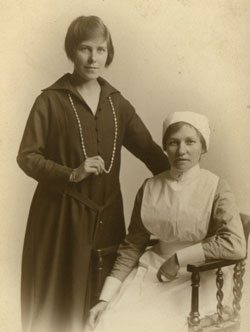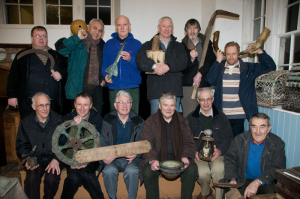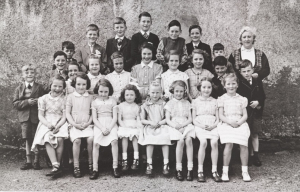The Lemreway school existing before 1881 was established by the Ladies Highland Association. The teacher was known as Murchadh Ban, a godly man from Uist. He was followed by Donald MacKay who afterwards went in for the ministry and served for many years as an evangelist in the Highlands and Islands. The public school opened in 1881.
The first headmaster was Donald MacIver (Domhnall Ruadh a Bhodaich Bhain), born in the parish of Uig in 1857. He left Lemreway in August, 1883 when he was appointed headmaster at Breasclete, where he remained for thirteen years. Following Breasclete he went to Bayble in 1896 and stayed there until his retirement in 1922. He is remembered today as the composer of the Gaelic song An Ataireachd Ard.
When Mr MacIver came to Lemreway he brought his sister, Margaret with him as housekeeper. His father, Am Bodach Ban, a retired teacher with the Gaelic School Society also joined them and became a leading member of the new Free Church at Gravir which opened on the first Tuesday of November 1882. Margaret later became the second wife of Kenneth MacMillan (Coinneach Dhonnachaidh). They were the parents of Angus MacMillan “The Hero of Buzancy” whose life story, written by his son the late Rev Kenneth MacMillan was published by the Historical Society in 1993.
June 7th. 1881
This school opened today for the first time by Donald MacIver, Certificated Teacher of the Third Class. The teacher after spending most of the day finding out the extent of the children’s attainments, find that the work in future will be very elementary.Of the 25 present only 12 know the alphabet properly, a few of these can read fairly number 2 and number 3 Royal Readers. Only 1 boy and 2 girls can write and the acquirements in arithmetic are equally backward.
February 20th. 1882
Opened school as usual but only 12 children came. Advised during the day by Dr. Ross to close school as Typhus seems to be raging in the district.
October 13th. 1882
Compulsory Officer was in school on Monday. He does nothing towards bettering the attendance of the school so that as far as I can see, he is, in his capacity quite useless. Everything assumes an air of indifference as far as school matters are concerned.
November 24th. 1882
I am sorry to understand that one of the pupils has died this week of the whooping cough. Had a visit on Thursday from Mrs Platt, Eishken Lodge, who was pleased to give two sewing prizes to the girls. This lady takes much interest in the industrial work of the school.
December 4th. 1882
“These certify that I am of the opinion that owing to an outbreak of measles at Lemreway, the Public School ought to be closed for a few weeks” Signed Rodk. Ross, Medical Officer for Lochs
“These certify that owing to the prevalence of whooping cough in the township of Lemreway (almost all the children being affected), I am of the opinion that the Public School in said village ought to be closed from this date till the epidemic subsides”
Signed Rodk. Ross, Medical Officer for Lochs
SCHOOL RE-OPENED 5th. January, 1883
May 16th. 1883
Of the 59 pupils on the roll a week or two ago, only 19 put in an appearance today. It is probable that not more than 2 or 3 of them will be present tomorrow.The work is over for the season; the weather is good and I can’t account for my school attendance.
June 15th. 1883
It should be remarked here that the sewing always depend on the quantity of material at sewing mistress’ disposal. Girls could never be got to take any stuff to school with them for sewing.
August 31st. 1883
School closes for 5 weeks holiday. Present teacher has bidden farewell to the scholars as he is about to leave to another school.
Posted by cepaircadmin




